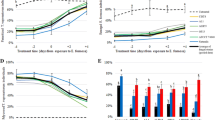Abstract
Five strains ofMetarhizium anisopliae (Metsch.) Sorokin and one strain ofMetarhizium flavoviride Gams & Rozsypal originally isolated in Madagascar were studied. Measurements of conidia and, for the first time, also of blastospores produced in a liquid medium were used for species and variety determination. Blastospores ofM. flavoviride were more homogenous in their size than those ofM. anisopliae. Growth at high temperatures between 25° and 40°C showed that 4 isolates ofM. anisopliae grew at 36°C andM. flavoviride grew at 38°C. Using alternating day/night temperatures (8/16 h) the three strains tested could also tolerate 40°/25°C. In bioassays, fiveMetarhizium spp. isolates were tested against third and fourth instar larvae ofLocusta migratoria (L.) at two alternating day/night temperatures of 30°/25°C and 36°/25°C. In the cooler regime, all strains caused a mortality of 50% within 5.9 to 8.5 days (median lethal time), while in the 36°/25°C treatment only the thermophilicM. flavoviride and oneM. anisopliae strain isolated from a soil sample gave comparable results with median lethal times of 6.8 and 7.3 days, respectively.
Résumé
Les auteurs ont étudié cinq souches deMetarhizium anisopliae et une souche deM. flavoviride isolées à Madagascar. Les blastospores de la seconde espèce apparaissent plus homogènes de taille que celles deM. anisopliae. Quatre des 5 souches de cette espèce peuvent croître à 36°C tandis que l'isolat deM. flavoviride se développe à 38°C (températures constantes). Cette souche ainsi que deux souches deM. anisopliae sont capables de croître à des températures de 40°C (pendant 8 h) alternant avec des températures de 25°C (pendant 16 h). Dans les essais d'infection de stades L3/L4 deLocusta migratoria à une température de 30°C (pendant 8 h) alternant avec une température de 25°C (pendant 16 h), les 4 souches deM. anisopliae et la souche deM. flavoviride ont toutes donné une mortalité de 50% en 5,9–8,5 jours. Dans le cas où la température est de 36° au lieu de 30°C (pendant 8 h), seule la souche deM. flavoviride et une souche deM. anisopliae isolée du sol ont donné des mortalités élevées.
Similar content being viewed by others
References
Adamek, L. — 1963. Submerse cultivation of the fungusMetarhizium anisopliae (Metsch.). —Folia Microbiologia (Praha), 10, 255–257.
Bateman, R.P., Carey, M., Moore, D. &Prior, C. — 1993. The enhanced infectivity ofMetarhizium flavoviride in oil formulations to desert locusts at low humidities. —Ann. Appl. Biol., 122, 145–152.
Fargues, J., Maniania, N.K., Delmas, J.C. &Smits, N. — 1992. Influence de la température sur la croissancein vitro d'hyphomycètes entomopathogènes. —Agronomie, 12, 557–564.
Glare, T.R. &Milner, R.J. — 1991. Ecology of entomopathogenic fungi. — Handbook of Applied Mycology, Vol. 2: Humans, Animals, and Insects (D.K. Ajello &K.G. Mukerji, eds.),Marcel Dekker, New York, 547–612.
Jenkins, N.E. & Prior, C. — 1995. Growth and formation of true conidia byMetarhizium flavoviride in a simple liquid medium. —Mycol. Res., 97 (in press).
Johnson, D.L. &Goettel, M.S. — 1993. Reduction of grasshopper populations following field application of the fungusBeauveria bassiana. —Biocontrol Sci. & Technol., 3, 165–175.
Kleespies, R. — 1993. Untersuchungen zur Biologie und Anwendung des entomopathogenen PilzesMetarhizium anisopliae (Metsch.) Sorokin zur biologischen Bekämpfung afrikanischer Wanderheuschrecken. —PhD thesis, TH Darmstadt., 348 pp.
Kleespies, R.G. &Zimmermann, G. — 1992. Production of blastospores by three strains ofMetarhizium anisopliae (Metch.) Sorokin in submerged culture. —Biocontrol Sci. & Technol., 2, 127–135.
Latch, G.C.M. — 1965.Metarhizium anisopliae (Metschnikoff) Sorokin strains in New Zealand and their possible use for controlling pasture-inhabiting insects. —New Zealand J. agric. Res., 8, 384–396.
Müller-Kögler, E. — 1965. Pilzkrankheiten bei Insekten. —P. Parey, Berlin & Hamburg, 444 p.
Prior, C. — 1992. Discovery and characterization of fungal pathogens for locust and grasshopper control. —Biological control of locusts and grasshoppers (Lomer, C.L. &Prior, C. eds.), CAB International, Wallingford, 159–180.
Prior, C. &Greathead, D.J. — 1989. Biological control of locusts: the potential for the exploitation of pathogens. —FAO Plant Protection Bull., 37, 37–48.
Roberts, D. W. & Campbell, A.S. — 1977. Stability of entomopathogenic fungi. —Environmental stability of microbial insecticides (Ignoffo, C. M. & Hostetter, D. L. eds.), Misc. Publ. Entomol. Soc. Am. 10, 19–76.
Scherer, R, Bateman, R.P., Moore, D. & McClatchie, G.V. — 1992. Control of the migratory locustLocusta migratoria capito in Madagascar: the potential for the use of a myco-pesticide. —Brighton Crop Protection Conference — Pests and Diseases, 357–362.
Tulloch, M. — 1976. The genusMetarhizium. —Trans. Br. Mycol. Soc., 66, 407–411.
Zimmermann, G. — 1986. The “Galleria-bait method” for detection of entomopathogenic fungi in soil. —Z. angew. Ent., 102, 213–215.
Zimmermann, G. — 1993. The entomopathogenic fungusMetarhizium anisopliae and its potential as a biocontrol agent. —Pesticide Science, 37, 375–379.
Zimmermann, G., Zelazny, B., Kleespies, R. & Welling, M. — 1994. Biological control of African locusts by entomopathogenic microorganisms. — New trends in locust control (S. Krall & H. Wilps, eds.), Schriftenreihe der GTZ 245, Eschborn, 127–138.
Author information
Authors and Affiliations
Rights and permissions
About this article
Cite this article
Welling, M., Nachtigall, G. & Zimmermann, G. Metarhizium spp. isolates from madagascar: Morphology and effect of high temperature on growth and infectivity to the migratory locust,Locusta migratoria . Entomophaga 39, 351–361 (1994). https://doi.org/10.1007/BF02373040
Received:
Accepted:
Issue Date:
DOI: https://doi.org/10.1007/BF02373040




